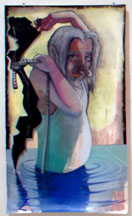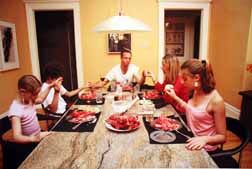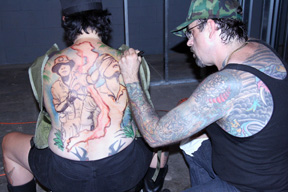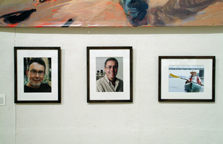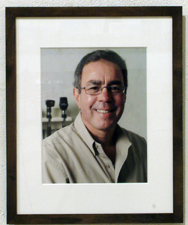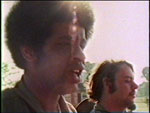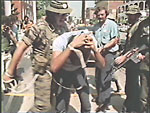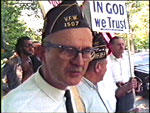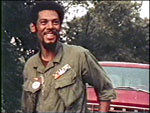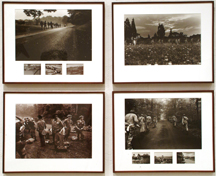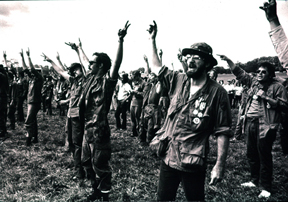


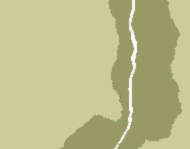
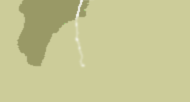
// ARTISTS //
|
|
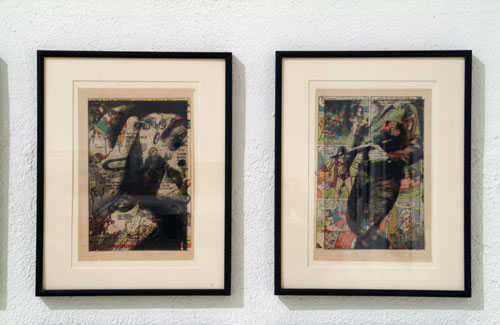 |
Ron Abram Engrams (1970), Intaglio , 2005 |
| _____ | |
Stefan Abrams and Amy Adams : "Hey Johnny, What are your rebelling against?" "What've you got?" archival pigment print 2005 |
|
| _____ | |
Terry Adkins: Anthem, Lone Wolf Recital Corps, 2003
|
|
| _____ | |
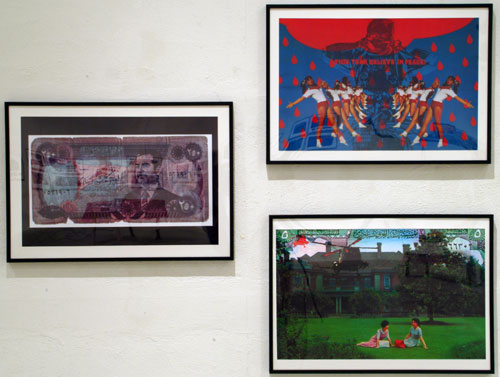 |
Sam Belkowitz The Great Steal, Plotter Print 2003 : Our Korea Plotter Print 2004 : This Year Believe in Peace Plotter Print 2004 |
| _____ | |
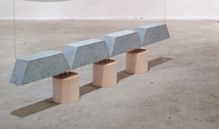 |
Shanon Bowser End Return Concrete, wire, wood 2005 |
| _____ | |
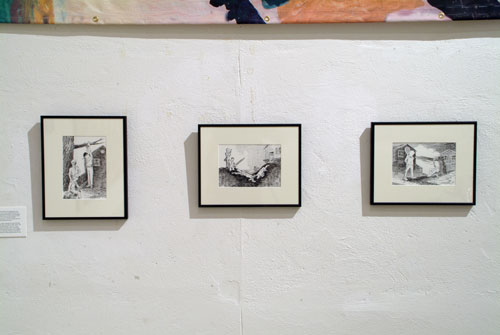 |
Brian Brotman Hangman, ink on paper, 2005: Family, ink on paper, 2005: Stop, ink on paper, 2005 To me, the most striking idea about Operation RAW was bringing war to an American middle-class setting. The current war in Iraq is totally remote from America . The way that the Iraq War is being reported sanitizes all of the graphic violence from it. Most people go on living their lives as normal, unaware of the brutal conflict overseas. During the Vietnam War, the Operation RAW protestors were able to raise attention to the horrors of war, and they did so in a way that was attention grabbing, surreal, and darkly humorous. Inspired by the Operation RAW protestors, these drawings are about showing the real cost of war in a suburban setting. As they journeyed on their march, the protestors reenacted the atrocities they had experienced in Vietnam . These drawings are as if a real army marched through a suburban town, committing atrocities. The context of the American town makes the violence more tangible than the remoteness of Iraq . They are done in the style of Goya as a parody of the Disasters of War. Ultimately, they are about the dehumanizing nature of war.
|
| _____ | |
 |
gerard brown Possible outcomes, Text and buttons in an edition of 250 per design 2005 I was moved by the wording of fliers passed out by veterans at the march describing activities in which they had participated as soldiers in Viet Nam . It struck me that these horrific yet mundane actions - at once the backbone of war and the last things I would wish done to another person in my name - were not isolated events stuck in a certain historical moment. They are endemic behaviors of soldiers that all soldiers might potentially carry out, under orders or as an understood aspect of following orders. |
| _____ | |
 |
Charles Burns For Jimmie Hendrix, Photo Copy in Plastic Sleeve, 2005 |
| _____ | |
 |
Mark Campbell A Personal History of the Vietnam War, from the series "Autobiography" C Print / Audio Disc 2005
|
| _____ | |
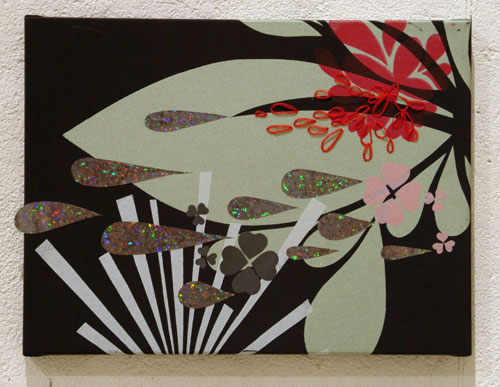 |
Candy Depew Hearts cry, heavy with the Darkness that flows like water across the lands of Yesterday and Today Silkscreen fabric pigment on cotton, red thread unwoven from an American flag from the early 1970's, mylar glitter sticker August 2005 in commemoration of Operation RAW exhibition |
| _____ | |
Jessica Doyle ink and acrylic on paper, 2005 I am 28 years old and I do not have any direct or immediate connections to the Vietnam War or protest. The first thing that comes to my mind when presented with the topic of the Vietnam War or War in general is the War in Iraq and my family member who currently serves in the Armed Forces. He is my brother-in-law and he is in the Army reserves. He comes home every few months and has a young family. He is only 24 and is married with a 3 year old daughter and 4 month old son. Watching him with his family for a couple of days to a week that he spends with them is indescribable. What patience they have to live like that. They make up for months lost in days. I saw a photograph of Matt with his daughter, Victoria, both in Army fatigues. His daughter was elated and glad that she was with her dad. It is a beautiful and sad picture. In my drawing, I have put this current day depiction in to the past setting of Vietnam .
|
|
| _____ | |
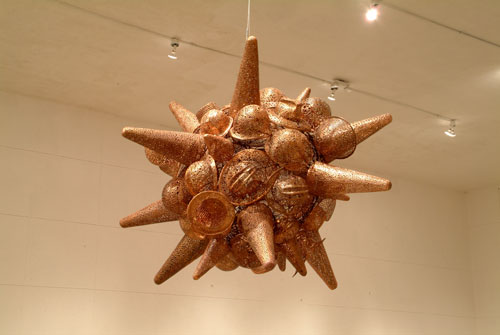 |
Steve Donegan Reliquary, copper, 6ft. diameter, 2005
From European Christian tradition of the Middle Ages, a reliquary is a sacred container believed to hold a body part or fragment from the life of a saint. They are characterized by elaborate designs and laborious craftsmanship in glowing precious metal to emphasize the spiritual nature of its contents. What is contained is often represented as part of the object’s design. If the reliquary contains a joint of a finger, the reliquary will include the idealized representation of a finger or a hand. As an artifact of belief and symbol, the reliquary is a highly charged object of commitment and commemoration, one that can function both as a cautionary signal while also inspiring an irrational devotional response. Adapting an intricate process designed to attract and hypnotize, as war insidiously continues to be, I am suggesting the appalling and mindless loss that is the inevitable outcome. I have envisioned the reliquary as a symbol of mourning and commemoration. By way of its shimmer and gloss, it is designed to repel and antagonize while hats and helmets crowd towards its lethal center.
|
| _____ | |
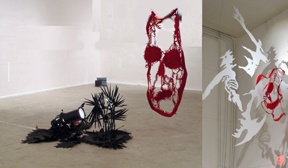 |
Paul Swenbeck and Joy Feasley |
| _____ | |
Matthew Fisher March Acrylic on Linen 2005 Courtesy of the Artist I just wanted to do a piece that dealt with the feelings of being a soldier. Not necessary with what the soldiers are doing in regards to the War(s). |
|
| _____ | |
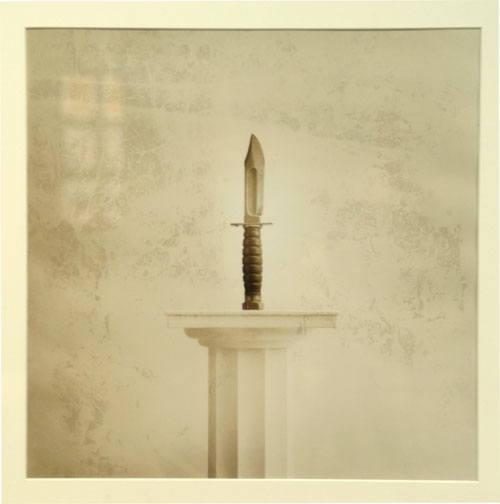 |
Susan Fenton Vietnam Still Life Toned Gelatin Print 2005 |
| _____ | |
Sherman Fleming Apologize Decal 2005 This piece is the image for the gallery exhibit. My installation involves placing "Apologize decals" in locations between the gallery and the Vietnam Soldier Memorial, Philadelphia . |
|
| _____ | |
 |
Don Fox Silent Witness Photography-based digital mixed media 2005 Courtesy of the Artist In The Things They Carried , the award-winning fictional account of the effects of the Vietnam War on those who experienced it first-hand, author Tim O'Brien speaks of two kinds of truth: what really happened versus an artist's portrayal of the essence of what happened. "Sometimes," he says, "story truth is truer than happening truth." Among the things I have carried all these years is a photograph of the haunted and haunting face of this ordinary Vietnamese woman whose life is inextricably caught in the crosshairs of history. Modern digital technology has enabled me to take this single "happening truth" and explore some of the "story-truths" that lie within it. Each iteration of her face reveals a different "truth" about war, the victims of war, and the effects of war, as well as truths about the humanity and dignity of those caught up in it. As you look at these iterations, what "truths" to you find in this old woman's face? |
| _____ | |
Will Gabaldon Untitled, oil on canvas 2005 |
|
| _____ | |
Sarah Gamble Post Traumatic Stress Disorder, oil on canvas , 2005 This painting is about post-traumatic stress disorder which I am certain many Vietnam or any war veterans go though. Waking up in the middle of the night freaking out is something lots of people can identify with. I am not comparing one persons paint or anxiety to another’s. It’s just that it is one little way we can all identify with each other. |
|
| _____ | |
Arthur Gonzales Artnam mantrA , oil and oil stick on paper 2005
|
|
| _____ | |
Patrick Grugan Where hope comes from, oil on board, 2005 |
|
| _____ | |
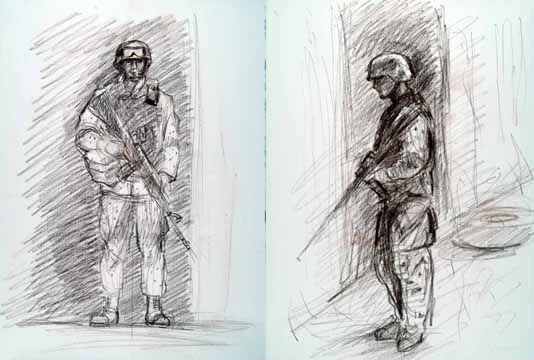 |
Susan Hagen Soldier Drawing #1, 2, 3, 5, 6, 11, conte on paper, 2004-2005 This series of conté and charcoal drawings is based on current images of American soldiers in Iraq found in newspapers, magazines, books, documentary films and on television, supplemented with information from interviews with soldiers and veterans and from studies from life. The drawings have been used as preparatory studies for a new series of sculptures titled The Lost Army, which will be exhibited at Schmidt Dean Gallery in Philadelphia from September 9- October 15, 2005 . In The Lost Army I have turned my attention to the subject of the ongoing United States occupation of Iraq – focusing on the individual American soldiers who have served there. The Lost Army is a monument to these soldiers and consists of a series of one-foot tall, carved wood soldiers, charred velvety black, complete with gear and weapons that will be displayed together as an installation. |
| _____ | |
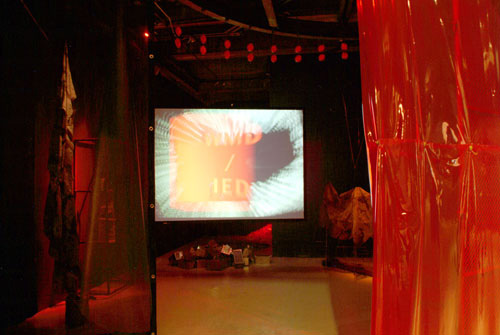 |
Carolyn Healy and John Phillips More Bloody Lies Sculpture/video 2005 |
| _____ | |
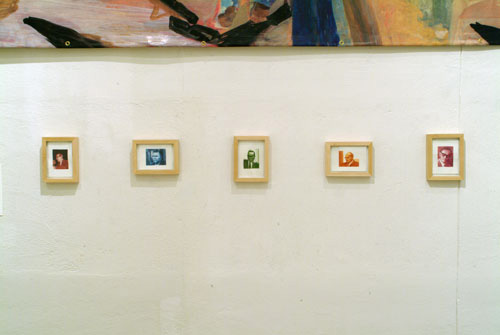 |
Mary Henderson Dean Rusk, Robert MacNamara, McGeorge Bundy, Walter Rostow, William Bundy Watercolor on paper 2005
My project is a series of 5 tiny monochrome watercolors. The subjects are: McGeorge Bundy: National Security Advisor, Kennedy and Johnson administrations; William Bundy: brother of McGeorge; Deputy Assistant Secretary of Defense under Kennedy (later Assistant Secretary of State under Johnson); Walter Rostow: Deputy Special Assistant to the President for National Security Affairs, reporting to McGeorge Bundy (later National Security Adviser to Johnson) ; Robert McNamara: Secretary of Defense, Kennedy and Johnson administrations ; Dean Rusk: Secretary of State, Kennedy and Johnson administrations Parallels are often made between the Vietnam War and the present war in Iraq . And there are similarities. In both cases, the U.S. finds itself propping up a government which lacks the means to defend itself and fighting an insurgency that, while incapable of defeating the U.S. militarily, also can’t be defeated militarily by it. But there is, I think, something very dissimilar about the various attitudes and figures that led us into the two wars. The policies that sent us into Vietnam reflected a near- consensus about what threats the nation faced and how the U.S. needed to act in order to contain those threats. It was only after those policies unraveled that the country became divided. The present war, on the other hand, was one we went into as an already divided nation. And its architects have exploited and exacerbated those divisions throughout. So, essentially, the subject of this is the moment before things went sour and the very terrible consequences of the early escalation became clear. I wanted the paintings to evoke the sense of unity and certitude that the Vietnam War effectively ended. In the context of the show, you could consider my piece a "prequel." |
| _____ | |
 |
M. Ho Untitled, collage on newspaper 2005 |
_____ |
|
Richard Hricko Tommy - 1967, Digital Photograph 2005 My brother's Army photograph taken before he shipped out to Vietnam in 1967 |
|
| _____ | |
Cathleen Hughes and Alex Taylor Untitled, acrylic on canvas 2005 |
|
| _____ | |
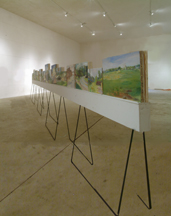 |
Jane Irish Operation Rapid American Withdrawal oil on chalk ground , 2004-2005 38 canvases; one canvas collection of LaSalle University Archive, Imaginative Representations of the Viet Nam War From April – September 2004, I traveled the route of the Operation RAW march and completed a cycle of 19 paintings plein air, French easel and all, which took me as long (exactly 87 hours -paint to canvas) as the march took. While I was on the site, I carried documentation in the form of articles and photographs, and when bystanders approached, which is often the case for landscape painters, I would tell the story of the event. At the same time, I was reading the literature of Vietnam , and came to experience the New Jersey and Pennsylvania landscape through the eyes of these great writers. I hope this has come through in the landscape paintings, it deepened my understanding and experience of the pilgrimage I had originally viewed solely as a protest march. n 2005, I completed this piece in the studio by painting 19 combat paintings depicting either dead soldiers, figures in fear, damaged landscapes, rain, and other Vietnam images. These paintings suggest the memory in the landscape of the marching antiwar vets.
|
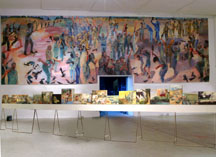 |
Jane Irish Breaking Arms digital production of painting 2005 |
| _____ | |
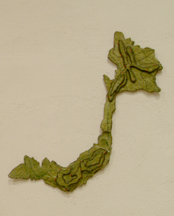 |
Jeanne Jaffe and Anne Seidman Gook, paper clay/acrylic/medium/ink/pins 2005 |
| _____ | |
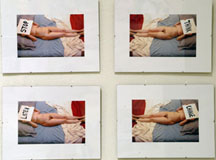 |
Christianne Kapps Stop, Thin, Listen, Change Digital Prints 2005 We are naked in the face of History Our very loud cries of "STOP" or "Listen" go unheeded as events swirl around and around, faster and faster until we are paralyzed and deaf Bad news tumbles up and around us like cold air after a hot shower and we are frozen in place It is the stunned silence that allows us to open our eyes and ears and minds Why does it take the rush of too much to teach us moderation, acceptance, forgiveness? Truisms fall about our feet and crunch when they are stepped on, and wait for next Spring for the chance to be regrown, reheard, respoken Each generation reinvents ways of being horrible to each other; will we also learn to stop? |
|
Juliana Espana Keller RAW Digital Photograph 2005 RAW Performance |
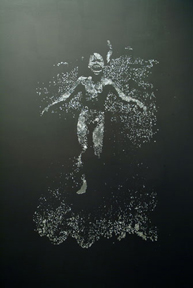 |
Nicholas Kripal
Specter (after UT) Metal Leaf Wall Drawing 2005
|
| _____ | |
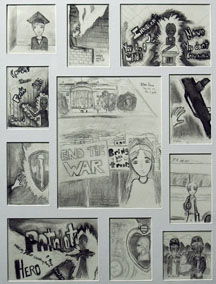 |
Kit Layfield Untitled Pencil 2005 |
| _____ | |
| Tristin Lowe Flash Point Gunpowder and ignition wire on paper 2005 The Work is an homage to Terry Fox. In 1970 he performed Defoliation, in protest of the U.S military’s scorched earth policy. 1970 – Terry Fox explains in an interview: In front of the museum was a large garden of jasmine plants, which bloom once every seven years. They had been growing for five years and were to bloom in two years. During the opening of the exhibition Fox cremated these plants with a flamethrower of the type used in Vietnam to provide the wealthy people who regularly enjoyed the garden with a concrete example of the type of action they supported with their dollars and their complacency. I burned the whole thing with a flamethrower, and it just left a slight border of these plants, and they ended up having to dig them all out, it destroyed them. So, then, the next day when these people came to have their lunch there, it was just a burned- out plot, you know. I mean, it was the same thing that they were doing in Vietnam . Nobody would get excited about napalming Vietnam, but you burn some flowers that they like to sit near. (Defoliation, University Art Museum, Berkeley, California |
|
| _____ | |
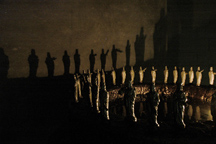 |
Gabriel Martinez Mixed media 2005 On the occasion of the 35th anniversary of Operation RAW I offer this memorial for those who have lost their lives in recent American wars. |
| _____ | |
|
Karen Mauch Tony, member of Operation RAW Color Inkjet Photograph 2005 Karen Mauch Photography C. 2005 Henry, member of Operation RAW Color Inkjet Photograph 2005 Karen Mauch Photography C. 2005 Jan, member of Operation RAW Color Inkjet Photograph 2005 Karen Mauch Photography C. 2005 I consider Jane Irish's work on the Vietnam war as stimulus to wake a muted collective memory of a time when voicing critical opinions mattered, no matter how unpopular and indeed even dangerous. It also is a challenge to all to shed our common complacency about the horror that our government is again and still wreaking. Like many others, I participated in protests in Philadelphia and D.C. during the Vietnam war. I am struck by how eerily similar our times are to those then, when negative views are squelched by the media and government, and fear of the consequences to dissent is palpable. The bridge from then to now was brought home for me when I met Tony, Henry and Jan. Their presence, and their words, evoked a powerful feeling of a time when passion and conviction could affect change. They, and this exhibition, are a foundation for a new generation to think about and understand the Vietnam history in light of the "new Vietnam " in Iraq . |
| _____ | |
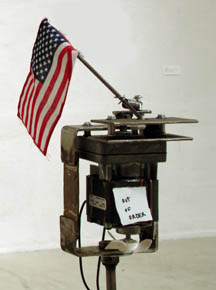 |
Kait Midgett #1 Patriot Metal motor, flag 2005 |
| _____ | |
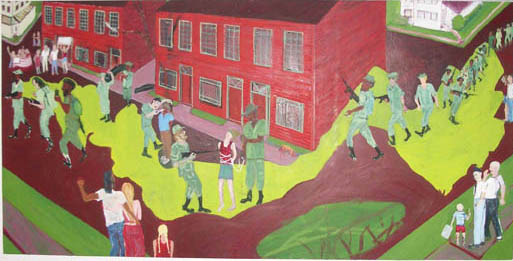 |
Sarah McEneaney September 1970 egg tempera on wood 2005, Courtesy Tibor de Nagy Gallery In September of 1970 I was 15 and entering my sophomore year of high school in a suburb of New York City . Though my knowledge of the Vietnam War was limited to the daily newspapers and evening television broadcasts I knew enough to be sure that our involvement in Vietnam was wrong. During my junior year I started attending antiwar rallies in New York and Washington DC . while in social studies we were reading excerpts from Frances Fitzgerald's Fire in The Lake. For the painting I re-imagined the march and a mock “search and destroy” mission in a small village. I studied the news photographs and stills from Different Sons to depict a line of soldiers entering a town, taking captives by force and violence and then marching on. I depicted myself, at 15, first as a bystander, then as one of the targets of interrogation and torture and finally as a supporter of the Vietnam Veterans Against the War.
|
| _____ | |
 |
Susan Moore Blindfold I paintstick 2005 Blindfold II paintstick 2005 |
| _____ | |
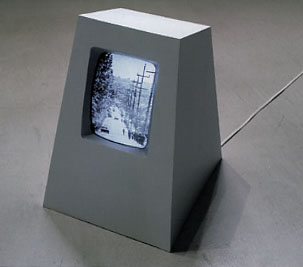 |
Joshua Mosley Untitled B/W Video tube, DVD, Wood, Resin, Paint 2005 |
| _____ | |
|
Jack Ofield Different Sons, Vietnam Remembered, 1970. On the road with the Vietnam Veterans Against the War Producer-Director: Jack Ofield , Producer: Robert J. Sann ; The original 56-minute documentary reissued in a new half-hour version, January, 2004. Images from the film Different Sons are used by permission of its maker, Jack Ofield . Different Sons© Jack Ofield , Bowling Green Films, Inc. 1971. Taping, photographing, or copying the film Different Sons in any manner is prohibited. All rights are reserved. |
| _____ | |
 |
Sharyn O'Mara Missing Man Chalk on floor 2005 |
| _____ | |
Michael O'Reilly
Video and mixed media 2005
|
|
| _____ | |
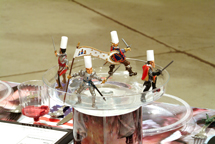 |
Tom Porett Preemptive d'gustation Mixed media 2005 This installation mixed media piece has been created as a protest against the too often used power of the United States government to try by subversion or outright military intervention to achieve policy goals. The motivations driving these goals are varied but usually not truthfully stated. This essentially amounts to lies, stated in order to gain public support. The Iraq pre-emptive invasion is among the most recent and clear examples of this technique. Pre-emptive d’gustation consists of a table setting consisting of a flag motif paper tablecloth and placemats derived from frames of the “Different Sons” film by Jack Olfield. Toy soldiers are attached to eating utensils, symbolizing the combatants being used as utensils of ideological intervention. Napkins are also flag motifs but inverted, a symbol of distress. The centerpiece consists of medieval warriors fitted with the faces and chef hats of the four presidents, Kennedy, Johnson, Nixon and G.W. Bush. Finally is the menu with the chef’s choice interventions. Pre-emptive d’gustation focuses on those most obvious interventions in which there have been few if any real threats to the USA , but have been conjured through ideology to provide justification. I have focused primarily upon three interventions; the Bay of Pigs abortive attempt to overthrow Fidel Castro, the Vietnam war and the second Iraqi war. In addition I have made references to the Spanish-American war that led to the “manifest destiny” concept of hemispheric (now global) justification for intervention. Another reference was the successful overthrow (murder) of Salvador Allende in Chile . Other examples exist but the ones chosen were among the most blatant examples. A nation most certainly must protect itself and does indeed have interests to protect. The war against the Taliban in Afghanistan was one such example as individuals that had trained in that country attacked the US . The aftermath of scaling back reconstruction in Afghanistan has been an unfortunate consequence of the Iraqi debacle. Aside from the consequences usually meted out to a civilian population in any war, the wonton waste of young men and women in the military is despicable. It is clear that perhaps a majority of the military is convinced that the Iraq war is right and justified. Most of these individuals are truly convinced in the righteousness of the cause. I take issue with their conclusion but honor their dedication. It is the leaders of such endeavors that I have targeted in the artwork. The “chefs” of these interventions readily commit the precious lives of the military to ill-conceived adventures that cost us dearly in talent and devotion to country The piece is dedicated to two individuals, William Rawson and Carl Thorne-Thompson who lost their lives in Vietnam . |
| _____ | |
Cynthia Porter Figure muslin and digital print 2005 |
|
| _____ | |
Andrew Prayzner
Range oil on canvas 2005 |
|
| _____ | |
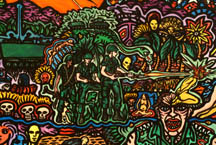 |
Huston Ripley
Sacrificial ' Nam acrylic on canvas 1992 Courtesy of Frank Klock |
| _____ | |
 |
Sarah Roche Black Heart india ink on paper 2005 In Black Heart, swords and armor from the Middle East are reflected in the glass case containing a suit of European armor. The armor gallery at the Philadelphia Museum of Art inspired this image, where historical antagonists face off for posterity. This conflict with the Other is entrenched in our psyche. Our pre-modern president spoke early on of the invasion of Iraq as a crusade. To his apparent surprise he was told that this was an offensive term. In fact a modern day crusade has already begun. Although religion isn’t spoken of officially as a rationale for war these days, our cultural memory helps us connect the dots. After the Vietnam War it seemed that the country wouldn’t easily accept another ideological and unwinnable war. Yet we are repeating history with echoes of the Dark Ages. Our leaders have called on the crusaders in our hearts to crush the infidel. Our enemies are scorned for their idea of jihad. Somehow it is hard for many to notice the similarity between the enemy and us. |
| _____ | |
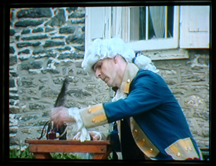 |
James Rosenthal Yankee Doodle Video on DVD 2005 |
| _____ | |
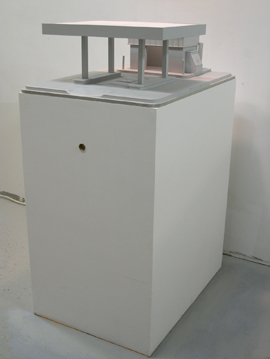 |
Mark Shetabi The Rapture MDF, plywood, acrylic, styrene, cloth, resin, metal, plexiglass, fluorescent light, and peephole lens 2005 Courtesy the artist and Ratio3, San Francisco
|
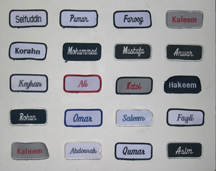 |
Mark Shetabi Readymade Found name tags 2005 Courtesy the artist and Ratio3, San Francisco
|
| _____ | |
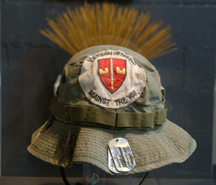 |
Larry Spaid Untitled Mixed media 1971-2005 |
| _____ | |
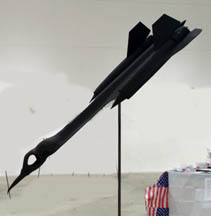 |
Clint Takeda Budgie ’72 Okinawa Plastic, steel, polyurethane foam, enamel paint 2005 |
| _____ | |
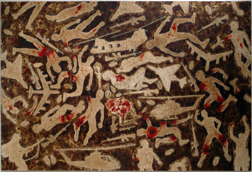 |
Ira Upin Shared Sacrifice Enamel, paper, over tar on door panels 2005 |
| _____ | |
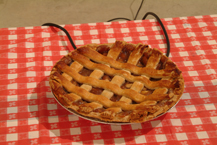 |
Jeremy Vaughn Weapons of Utter Frustration Mixed Media 2005 |
| _____ | |
|
Tony Velez Vietnam Memories : At War and Peace Vietnam Photographs, all small images 1966 -67; Vietnam Veterans Against the War, all large photographs from "Operation RAW" 1970 An inventory: Jockey Hollow Rd , Morristown NJ Silver print Twice Decorated Infantry Selenium print Sunrise Day Two Silver print Line of March I Silver print Al Hubbard Silver print Line of March II Silver print Rt. 202 Silver print Nurse for Peace Selenium print Sunrise Day 3 Silver print Assault Silver print Nurses and Veterans Silver print Time Out Silver print Henry Velez Selenium print Lone Soldier Silver print New York Times Silver print Assembling the Wounded Silver print Veteran Speaker Silver print Breaking of Arms Silver print Peace Silver print |
| _____ | |
Bill Walton Channel Marker / R.A.W. Wood 2005
|
|
| _____ | |
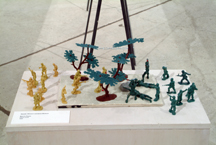 |
Natalie Wieters and Janet Richard Rest in Peace Mixed media 2005
|
| _____ | |
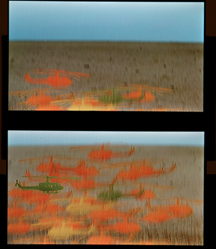 |
Sarah Zwerling Untitled LCD, DVD, Paper, Wood, Paint 2005 |
